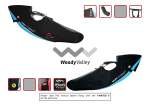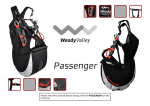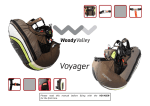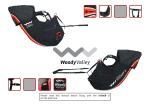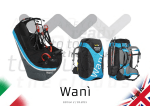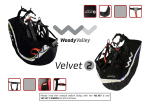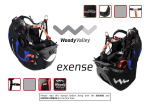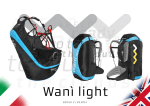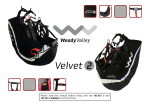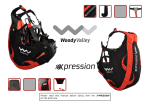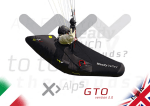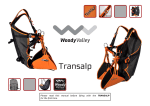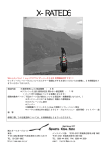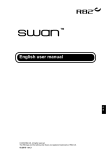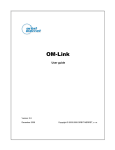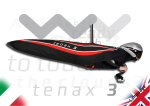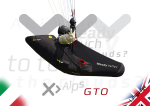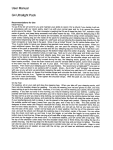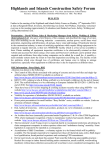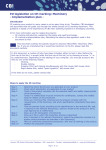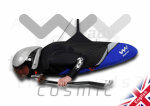Download Woody Valley Haska Manual
Transcript
AREYOU r eady t ot ouch ka as H t hecl ouds? THANK YOU! We would like to thank you for having chosen one of our products, and we invite you to read this important document, the User Manual for the harness. Please pay special attention to the two most important paragraphs, regarding: Insertion of the reserve parachute. The reserve parachute is a piece of equipment that may save your life. It must be treated so that it works correctly when it is required, whether this happens in two days’ time, or two years from now. Adjusting the harness. The harness forms the connection between the pilot and the paraglider, and it is an essential component in optimizing performance and the pleasure of flying. A bad harness that is well adjusted may enable you to fly well, but a good harness that is badly adjusted may put you off flying altogether. We are confident that this harness will give you greater comfort, control, performance and enjoyment in flight. We are conscious of the fact that reading an instruction manual is not an exciting experience. However, please remember that the respective product is not a citrus juicer or a mobile phone, and that correct use of the harness helps reduce the risk of flying accidents. This manual contains all the information necessary to assemble, adjust, fly and store your harness. Thorough knowledge of your equipment will improve your personal safety and your level of flying. Team Woody Valley SAFETY NOTE You have purchased a piece of equipment manufactured by us, and so you are aware of your identity as a paraglider pilot holding therespective pilot’s licence, and you accept all the risks connected to paragliding including the possibility of injury and death. The incorrect or inappropriate use of Woody Valley equipment greatly increases this risk. In no case can Woody Valley and the Woody Valley retailer be held responsible for personal injury caused to yourself or to third parties, or for whatever type of damage. If you have any doubts on the use of our equipment, please contact your retailer or the importer for your country. INDEX 1- GENERAL INFORMATION ..................................................................................................................................................................................... 1 1.1- CONCEPT ............................................................................................................................................................................................................................................... 2 1.2- PROTECTION AND SAFETY ..................................................................................................................................................................................................................... 2 1.3- S.O.S. LABEL ........................................................................................................................................................................................................................................ 3 2- BEFORE USING ..................................................................................................................................................................................................... 4 2.1- EMERGENCY PARACHUTE...................................................................................................................................................................................................................... 4 2.1.1- Connecting the deployment handle to the float bag ...................................................................................................................................................... 4 2.1.2- Connecting the reserve parachute to the harness.......................................................................................................................................................... 5 2.1.3- Inserting the reserve parachute........................................................................................................................................................................................... 8 2.1.4- Extracting the reserve parachute ........................................................................................................................................................................................ 9 2.2- HARNESS ADJUSTMENTS ................................................................................................................................................................................................................... 10 2.2.1- Seating position and back adjustment ............................................................................................................................................................................ 10 2.2.2- Shoulder-pad adjustment ................................................................................................................................................................................................... 11 2.2.3- Chest-strap adjustment ...................................................................................................................................................................................................... 12 2.2.4- Leg-strap adjustment .......................................................................................................................................................................................................... 12 2.3.5- Stabilizer .................................................................................................................................................................................................................................. 13 3- FLYING WITH HASKA ......................................................................................................................................................................................... 14 3.1- PREFLIGHT CHECKS ........................................................................................................................................................................................................................... 14 3.2- POCKETS ............................................................................................................................................................................................................................................ 14 3.3- CAMEL-BAG ........................................................................................................................................................................................................................................ 15 3.4- FLYING OVER WATER .......................................................................................................................................................................................................................... 15 3.5- ASSISTED TAKE-OFF HOOK ................................................................................................................................................................................................................ 16 3.6- LANDING WITH HASKA ..................................................................................................................................................................................................................... 16 3.7- DISPOSING OF THE HARNESS ............................................................................................................................................................................................................. 16 3.8- REGULATIONS FOR BEHAVIOUR IN NATURAL ENVIRONMENTS .......................................................................................................................................................... 16 4- PACKING THE HARNESS .................................................................................................................................................................................... 17 5- CHARACTERISTICS AND INSTALLATION OF OPTIONAL EQUIPMENT .............................................................................................................. 18 5.1- INSTALLATION OF THE SIDE PROTECTION .......................................................................................................................................................................................... 18 5.2- INSTALLATION AND ADJUSTMENT OF THE SPEED SYSTEM ................................................................................................................................................................ 20 5.3 --- RELAX - BAR ..................................................................................................................................................................................................................................... 21 5.4 --- QUICK-OUT SNAP-HOOKS................................................................................................................................................................................................................. 21 6- MAINTENANCE AND REPAIR ............................................................................................................................................................................. 22 7- CERTIFICATES OF APPROVAL ........................................................................................................................................................................... 23 7.1 --- GET-UP VERSION .............................................................................................................................................................................................................................. 23 7.2 --- T-LOCK VERSION .............................................................................................................................................................................................................................. 24 8- TECHNICAL DATA .............................................................................................................................................................................................. 25 1- GENERAL INFORMATION This equipment must contain: Harness Polypropylene seat with front flexible part Snap-hook Reserve parachute deployment handle 2 reserve elastic loops for closing the reserve parachute The available options are: Side protection Speed-bar Relax-bar Quick-out Snap-hooks 1 1.1- Concept HASKA is the new intermediate harness for all recreational pilots. Safe, plenty of features and comfortable. Thanks to the new geometry or the belts system derived from the X-RATED6 harness, we have obtained an excellent balance between manoeuvrability and stability. 1.2- Protection and safety With this new harness we have launched a new concept in spinal protection which we define as a self-inflating airbag. The innovation of this self-inflating system lies in the use of a steel spring which does not serve the purpose of protecting from impact, but generates the force needed to expand the airbag and make it immediately ready for potential impact. This means that your protective capacities are at 100% before you even start your take-off run, and that they remain as such for the entire flight, until you fold up the harness to stow it in the rucksack. The spring also guarantees a consistent form for the airbag and therefore performance over long periods of time, in any humidity, temperature or prolonged storage in the rucksack. Light weight and reduced volume (once the harness is folded) are two more advantages provided by the self-inflating spring system. This system combines the best characteristics of current protection systems (airbag and foam protection). Side protection is available as an option to protect the pelvis. The two side protection pieces are connected to one another and made in a single piece which prevents shifting during impact. In order to prevent the pilot from coming out of the harness if he forgets to fasten the leg-straps, the HASKA harness is equipped with the two most effective safety systems currently available - your choice of Get-Up or T-Lock. 2 1.3- S.O.S. label This label, coloured red with white lettering, is readily visible in a pocket on the right shoulder-strap padding. It is easy to pull out, and it is fastened to the harness to prevent it from being lost. On the back of this label, you can write the information that you think should be given to rescue personnel in case of accident. 3 2- BEFORE USING 2.1- Emergency parachute The housing for the reserve parachute is below the seat in the front part of the harness. The container is large enough for most reserve parachutes on the market today. The reserve parachute has to be linked to the harness before it is inserted into the built-in pocket. This connection takes the form of a dual bridle fixed to the harness at shoulder height, for better load distribution and to ensure a correct landing position in the case that the reserve parachute is deployed. This helps reduce the risk of injury to a minimum. The reserve chute bridle has a large central loop coloured red, and this is reinforced with a cover in Cordura 500. At the extremity of the loop, there is a Velcro band which enables the link with the reserve parachute to be held firmly in position. 2.1.1- Connecting the deployment handle to the float bag HASKA is supplied with a handle for reserve parachute extraction. It is identified with the number 6; this handle alone should be used for this purpose. The black loop attached to the handle itself should be passed into the loop on the deployment bag, and then the entire handle should be passed through its own loop and pulled tight. For easier extraction, the loop attached to the deployment bag should be positioned laterally with respect to the centre of the reserve parachute. If your deployment bag does not have this loop, please contact the retailer from whom you purchased the reserve parachute. 4 2.1.2- Connecting the reserve parachute to the harness There are three different methods of attaching the reserve parachute bridle to the harness bridle. First system: Use a screw-lock karabiner with a breaking strength of at least 2,400 kg. In this case, the bridles should be held in position within the karabiner using elastic bands, to prevent the karabiner from rotating and taking the strain laterally instead of vertically. The karabiner’s screw-lock should be tightly screwed shut to avoid any possibility of it opening accidentally. This type of connection can absorb a higher opening shock than the second system, and for this reason this is without doubt the recommended system. Second system: The reserve parachute bridle is passed through the loop at the end of the harness reserve parachute bridle. The reserve parachute itself is then passed through the large loop in the reserve parachute bridle. This connects the two bridles. The loops should be pulled as tight as possible to avoid any chance of dangerous friction developing between the two bridles during the shock caused when the reserve parachute opens. To ensure that the link between the two bridles remains tight, remember to fasten the knot using the Velcro strip on the harness reserve parachute bridle 5 Third system: If you are using a reserve parachute with directional control and dual bridle, or if your reserve parachute in any case has a double-riser bridle, it can be connected to the harness using the two loops positioned at the base of the harness bridle, near the padded shoulder straps. In this case, the harness’ reserve parachute bridle will not be used, and so it should be folded, fastened using two elastic bands, and positioned under the cover behind the pilot’s neck. The two connections should be made using screw-lock karabiners with a breaking strength of at least 1,400 kg. In any case, it is important to verify that the length of the bridle is sufficient to position the reserve parachute inside the harness pocket, and that there is sufficient play to enable the parachute to be taken out of the pocket without causing the reserve parachute deployment bag itself to open during extraction. 6 ATTENTION: -To prevent anomalous lateral loads, the bridle should be attached to both the loops on the shoulder straps. Not to just one of them. 7 2.1.3- Inserting the reserve parachute Insert the parachute in the harness container with the handle visible toward the outside and with the handle coupling loop to the float bag facing upward. Immediately position the handle in its specific housing. Introduce a thin rope (paragliding funicular strip type) into each elastic loop which you will use to help close the container. Introduce the elastic loops into the smallest of the eyelets on the flaps of the container. Take the bridle cover zip all the way to the right to then close it, moving the zip about 20 cm leftward. Then begin to close the various parachute container flaps, following the progressive order in the photographs, taking care during this phase that the zip does not open back up at the right end. 8 Introduce the handle’s metallic pins into the elastic loops and under the transparent cover. The cord must absolutely be removed at the end of this phase, and must be extracted slowly in order to avoid damaging the elastic loops due to excessive friction between the parts. In the end the zip should be completely closed until introducing the zip pull under the cover behind the left shoulder-strap. ATTENTION: Every new combination of reserve parachute and harness or the external container assembled for the first time should be tested by an official harness or reserve parachute dealer, or by a flying instructor. Deployment of the reserve parachute should be perfectly feasible from the normal flying position. 2.1.4- Extracting the reserve parachute It is vital to feel periodically for the position of the reserve parachute deployment handle during normal flight, so that the action of reaching for the reserve parachute handle becomes instinctive in an emergency. in emergency situations, the deployment procedure is as follows: - look for the reserve parachute handle and grasp it firmly with one hand - pull the handle outwards in order to extract the reserve parachute from the harness container - look for a clear area, and, in a continuous motion, throw the reserve parachute away from yourself and the paraglider - after the reserve parachute has opened, avoid entanglement by pulling in the paraglider, gripping at least one D line, or the brake lines, in order to collapse the glider - on landing, adopt an upright body position, and ensure that you perform a PLF (Parachute Landing Fall) to minimize the risk of injury 9 2.2- Harness adjustments HASKA harness provides a number of methods of adjustment so that the pilot can fly in the ideal position. A little time has to be invested in finding the optimum position, but this effort will be rewarded by exceptional comfort in flight. HASKA is supplied already adjusted to a standard ergonomic setting, apart from adjustments required for pilot height. Therefore, for the first flight we recommend adjusting the harness for height alone, leaving the other settings unchanged, because they have proved to be satisfactory for the vast majority of pilots. If you wish to change the other settings, remember that you can always return to the factory settings by making reference to the red marks on all adjustment straps. Before making any adjustments, the emergency parachute must be inserted. To adjust the harness to the optimum position, we recommend simulating flight position by hanging the harness from a suitable fixed point, therefore with all the items that you normally carry in flight inserted into the back pocket. 2.2.1- Seating position and back adjustment In this photo you can see how the back and seat depth adjustments are each subdivided on two points. The adjustment that allows you to select the inclination of the torso with respect to the vertical flight axis is No. 1. Adjustment No. 2 varies the angle between the legs and the back (seating depth), distributing the loads between the seat and the lumbar, thereby providing the pilot with greater comfort. 10 If you want to change the adjustments you must first adjust adjustment No. 1 to the most comfortable point. Once this step is completed, adjust the No. 2 seating depth belt to reach the new position desired. 2.2.2- Shoulder-pad adjustment Adjustment of the shoulder pads compensates for the variation in pilot height and the adjustment buckle is located in front of the pilot's shoulder. The shoulder pads also bear part of the weight of the upper body for improved comfort. We recommend adjusting the shoulder pads so that they fit against your shoulders without being too slack or too tight. 11 2.2.3- Chest-strap adjustment The chest strap which controls the distance between the two karabiners can be adjusted from 37 to 49,5 cm. For the first flight with HASKA, we suggest setting the chest strap to the minimum length, then locating the preferred length in flight by means of gradual adjustment. When the chest strap is shorter and tighter, stability is greater. An excessive distance between karabiners does not improve glider performance, and tightening the chest strap excessively may exacerbate the ‘‘twist’’ effect that may follow an asymmetric collapse of the sail. There is also a small elastic clip at the extremity of the padded shoulder-straps. This prevents the shoulders from slipping out of the straps during the launch run. The plastic clip also includes a useful whistle that can be used in emergency situations. 2.2.4- Leg-strap adjustment GET-UP SYSTEM: The high position of the leg attachment, typical of the Get-Up system, provides ample movement for the pilot’s legs. Normally the adjustment set by the manufacturer should be suitable. In the event that it is difficult to get into the harness after the take-off run, we recommend checking the seating angle of inclination (with the No. 2 adjustment described in point 2.2.1). If the problem persists, shorten the length of the leg-straps by acting on the two double window buckles located under the central chest-strap. T-LOCK SYSTEM: The same principles described for the Get-Up system apply, but in this case you will have to act on the double window buckles located on the leg-strap closing buckles. 12 2.3.5- Stabilizer This small but important adjustment makes it possible to stabilize the harness when you exert pressure on the speed-bar, preventing excessive tilt of the back. Its mode of operation is very simple: when you push the speed-bar, this small plastic buckle blocks the shoulderstraps at the point at which they slide in the chest strap, making the entire strap system more rigid and improving overall harness stability. This adjustment is correctly set by the manufacturer. ATTENTION: Every adjustment must be made symmetrically on both sides. 13 3- FLYING WITH HASKA 3.1- Preflight checks For maximum safety, use a complete and consistent system of pre-flight checks and repeat the same mental sequence every flight. Check that: all buckles are fastened. Take particular care in the case of ice or snow. Always clean off snow or ice before fastening buckles; - the reserve parachute handle is fastened in its correct position, and the pins are firmly inserted; - pockets and zips are closed; - the paraglider is connected correctly to the harness, and that both karabiners are locked closed by means of their locking system; - the speed bar is attached correctly to the glider. 3.2- Pockets HASKA has a spacious dorsal pocket and two side pockets, positioned respectively on the sides of the harness with zips to close them. A container for the camel-bag is fitted in the rear pocket. 14 3.3- Camel-bag HASKA is installation-ready for a camel-bag. Position your camel-bag in the container pocket located in the rear pocket. Pass the hose through the hole which is already predisposed at the top left of the rear pocket, pass it under the Lycra cover of the left shoulder-pad and bring it out the front from the specific hole as shown in the photo. 3.4- Flying over water There are no specific problems connected to flying above water using an HASKA harness, but in any case, landing in water is always dangerous. Woody Valley recommends using a suitable lifejacket when flying above water. 15 3.5- Assisted take-off hook HASKA harness can be used for towed launches. The tow bridle release should be hooked directly to the main karabiners, ensuring that the karabiners are positioned with the opening bar facing the rear. For further details, refer to the documentation provided with your tow release, or ask a qualified towing instructor at your flying site. 3.6- Landing with HASKA Before landing, slide your legs out and off the seat surface, so that you take up a standing position. Never land in the seated position; it is very dangerous for your back even if you have foam dorsal protection, which provides exclusively passive protection. Standing up before landing is an active safety precaution, and it is much more effective than passive forms of protection. 3.7- Disposing of the harness The materials used in a paragliding harness require a correct disposal. Please give your harness back to us instead of throwing it away, we’ll take care of its correct disposal. 3.8- Regulations for behaviour in natural environments Please respect the environment when you practise our sport: do not leave the beaten tracks, do not pollute with garbage, do not disturb the peace with loud noises. 16 4- PACKING THE HARNESS Packing the HASKA harness is similar to all the other harnesses with the only difference being in folding the rear part of the airbag which, in order to keep it intact, should be folding last above the rear part of the harness. 17 5- CHARACTERISTICS AND INSTALLATION OF OPTIONAL EQUIPMENT 5.1- Installation of the side protection HASKA provides the possibility of installing a side protection developed specifically for this harness. To install it you must lift the harness seat in order to create the space to work through (photo 1-2). Remove the standard protection positioned under the seat in two special bags (photo 3). Us the same housing to introduce the side protection (photo 4). Once arranged in the two central bags (photo 5), introduce the side ends of the protection in the elastic bags located on the sides (photo 6-7). Restore the seat to its original position. 1 2 3 4 18 5 6 7 19 5.2- Installation and adjustment of the speed system After having adjusted the sitting position to the optimum configuration, the accelerator must be adjusted. This harness is compatible with all normal types of speed-system accelerators. The elastic in front of the board that retains the speed-bar keeps the handle of your reserve parachute from becoming tangled in the event it is deployed. The pedal cords should be passed first through the rings fixed to the elastic in front of the board, then in the harness through the eyelets near the front corners of the seat, then through the sheaves located near the rear corners of the seat and finally through the small side rings mounted on elastic tape. This last step prevents the cord from ending up in the harness when it is unhooked from the shoulderstraps of the paraglider. o adjust the system correctly, the pilot has to adopt a flying position in the harness, suspended from a flight simulator, and hook into the risers of the paraglider. Another person then helps by supporting the risers, so the pilot can adjust the length of the speed-system cords. When no pressure is exerted on the speed bar, the bar must be at a distance no greater than 10 cm below the front of the harness. If the speed-bar cord is too short, it could cause a constant force on the bar during flight, so that the accelerator is unintentionally engaged at all times in flight. It is safest to take off with the speed-bar a little too long, progressively shortening it during the next flights. Remember that all adjustments have to be performed symmetrically, on both sides. 20 5.3 --- Relax - bar A relax-bar can be fitted to all our harnesses, except for those already incorporating this accessory. The relax-bar is used to keep the legs stretched out and the feet resting on a support. Some pilots consider this flying position as more comfortable than the classic seated position with legs hanging. To attach the relax bar to the harness, follow the instructions provided in the relax-bar instruction manual. 5.4 --- Quick-out snap-hooks HASKA provides the possibility of using ‘‘quick-out’’ snap-hooks. For correct installation see the use booklet provided with the snap-hooks themselves. 21 6- MAINTENANCE AND REPAIR Check the harness after every impact, bad landing or launch, or in the case that there are signs of damage or excessive wear. We recommend having your harness checked by your retailer every two years, and replacing the main karabiners every two years. To prevent unnecessary wear and deterioration of the harness, it is important to avoid its scraping against the ground, rocks or abrasive surfaces. Do not expose the harness unnecessarily to UV radiation (sunlight) outside normal flying activities. Wherever possible, protect the harness from humidity and heat. Store all your paragliding equipment in a cool, dry place, and never put it away while damp or wet. Keep your harness as clean as possible by regularly cleaning off dirt with a plastic bristle brush and/or a damp cloth. If the harness gets exceptionally dirty, wash it with water and a mild soap. Allow the harness to dry naturally in a well-ventilated area away from direct sunlight. If your reserve parachute ever gets wet (e.g. in a water landing) you must remove it from the harness, dry it and repack it before putting it back in the container. Repairs and replacement of harness components cannot be performed by the user, but exclusively by the manufacturer or staff authorized by the manufacturer. The manufacturer and authorized service staff alone can use materials and techniques ensuring correct product functionality and its complete conformity to product certification. The harness can be washed using a tepid solution of water and mild soap. Zip fasteners should be kept clean and lubricated with silicone spray. In the case of making any request to an official retailer or Woody Valley for maintenance operations, please quote the complete identification number shown on the silver label in the rear pocket. We hope that you enjoy great flights and happy landings with HASKA ! 22 7- CERTIFICATES OF APPROVAL 7.1 --- Get-up version 23 7.2 --- T-Lock version 24 8- TECHNICAL DATA Distance between karabiner and seat Size M cm 43; L cm 45; XL cm 47 Distance between karabiners (min - max), Get-up system Size M cm 37-48; L cm 37-48; XL cm 37-49,5 Distance between karabiners (min - max), T-Lock system Size M cm 37-48; L cm 37-48; XL cm 37-48 Size of polypropylene seat, size M Width rear 33 cm; Width front 30; depth 34 cm Size of polypropylene seat, size L Width rear 35 cm; Width front 32; depth 36,5 cm Size of polypropylene seat, size XL Width rear 37 cm; Width front 34; depth 39 cm Total weight, complete karabiners and protection with reserve parachute handle, Size M = 3,90 Kg; L = 4,15 Kg; XL = 4,40 Kg Type of protection Self-inflating airbag Type of straps Get-up / T-Lock Reserve parachute housing Under the seat, with lateral handle Number of certification Get-up system DHV GS-03-0384-13 Number of certification T-Lock system DHV GS-03-0383-13 Every effort has been made to ensure that the information contained in this manual is correct, but please remember that it has been produced for guidance only. This owner’s manual is subject to change without prior notice. Please check at www.woodyvalley.com for the latest information regarding the HASKA harness. Latest update: MARCH 2015 25





























